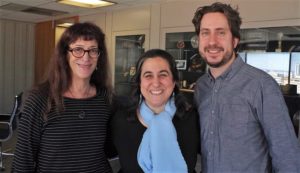Kairos Blanket Exercise opens doorway to learn about shared history

By Rick Garrick
TORONTO—Ryerson University’s March 23 Kairos Blanket Exercise was an emotional experience for a range of faculty and staff participants, with many breaking into tears at different points.
“I did actually [begin crying],” says Mandi Binder, faculty member with the School of Early Childhood Studies and teaching chair for the Faculty of Community Services. “When Curtis [Maloley, one of the exercise co-facilitators] laid the grey blanket for the residential school kids, that just did it, probably because I was a teacher for 22 years with very young children. So whenever I see something like that with children I have a very hard time.”
Binder says the exercise was “really powerful.”
“It hit me really hard when the residential blanket was laid and also the one with the smallpox hit me very hard,” Binder says. “So there was an incredible emotional response.”
Andrew Pettit, staff member with Athletics and Recreation, says the most telling part of the exercise for him was when the journal entry about using smallpox as a weapon was read aloud.
“I was one of the individuals who died,” Pettit says. “I was told: ‘You died of smallpox.’ And I had the really visceral reaction of rage—that just don’t say I died, I was murdered.”
Krista Effer, staff member with Undergraduate Admissions and Recruitment, says the exercise “could be life changing.”
“I need to go and spend more time thinking about it, but my immediate response was that as someone who has grown up as a neighbour to two Indigenous communities, Curve Lake and Saugeen Nation, that I spent a lot of my life not paying attention and not being aware of how the assimilation was working and how much we continue to treat Indigenous peoples as less than,” Effer says. “We have a lot to do. We need to start upholding our end of the treaties.”
Maloley, educational developer with the Learning and Teaching Office, says the exercise was held through a partnership between the Learning and Teaching Office and the Aboriginal Education Council.
“We wanted to begin to make sure that faculty, staff, students, that the community at large has an opportunity to form a shared history and a common sense of memory from which to work forward in the ways that we try to answer the Truth and Reconciliation [Commission’s] Calls to Action,” Maloley says. “The blanket exercise is one of the initiatives we have put together to try to instill that shared history in the community and to try to provide a framework for thinking through how we can move forward together.”
Rachel Barreca, manager with the Career Centre and one of the exercise co-facilitators, says the exercise is never easy to facilitate and is emotional, challenging and hard to do.
“It’s sometimes hard for me even as I’m facilitating it not to cry, especially when I see other people start to have emotional reactions,” Barreca says. “But that’s part of the learning. Our learning starts in the emotional reaction and then goes from there, so I think it’s important. They should be feeling emotional — these are hard conversations.”
Joanne Dellaire, Elder at Ryerson, says the exercise is also “permission giving” for participants.
“That’s why I like group work, because [when] you see one person being emotionally affected, it opens the doorway for other people to express it,” Dellaire says. “And then people can have that collective experience of being emotionally impacted by a section of Canadian history that brings great shame to all of us.”


